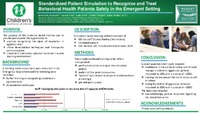Implementing high-flow nasal cannula therapy in the emergency department
View File(s)
- Author(s)
- Details
-
Maureen Lugod, MSN, RN, CEN; Ruth Karales, BS, RRT; Lisa Keller, RRT
- Sigma Affiliation
- Non-member
- Contributor Affiliation(s)
- Rush Copley Medical Center, Aurora, Illinois, USA
Visitor Statistics
Visits vs Downloads
Visitors - World Map
Top Visiting Countries
| Country | Visits |
|---|
Top Visiting Cities
| City | Visits |
|---|
Visits (last 6 months)
Downloads (last 6 months)
Popular Works for Lugod, Maureen by View
| Title | Page Views |
|---|
Popular Works for Lugod, Maureen by Download
| Title | Downloads |
|---|
View Citations
Citations
Patients with respiratory distress present to the Emergency Department (ED) primarily due to hypoxia, hypoxemia and hypercapnea. These critically ill patients are commonly managed using non-invasive ventilation therapy (NIV), which is comprised of Continuous Positive Airway Pressure (CPAP) and Bilevel Positive Airway Pressure (BiPAP). In our organization, patients requiring NIV therapy are admitted to the intensive care unit (ICU) or step-down area because of frequent monitoring. In addition, CPAP and BiPAP are considered ventilators, which require orders from providers who are credentialed with ventilator privileges. In analyzing the cost effectiveness of NIV therapy through retrospective chart review, it was identified that there were total of 94 ED patients placed on NIV, who were admitted to ICU in CY2017. The higher level of care was necessitated because of the need for a provider with ventilator privileges. This led the respiratory therapy (RT) and ED nursing teams to implement the use of high-flow nasal cannula therapy that addresses hypoxemia and hypercapnea as effectively as CPAP and BiPAP, but does not require ventilator-privileged provider orders. The purpose of this study is to examine the effect of implementing high-flow nasal cannula therapy on ICU admission of adult patients presenting in ED with respiratory distress/failure.
Items submitted to a conference/event were evaluated/peer-reviewed at the time of abstract submission to the event. No other peer-review was provided prior to submission to the Sigma Repository, unless otherwise noted.
| Type | Poster |
| Acquisition | Proxy-submission |
| Review Type | Abstract Review Only: Reviewed by Event Host |
| Format | Text-based Document |
| Evidence Level | Descriptive/Correlational |
| Research Approach | Pilot/Exploratory Study |
| Keywords | Emergency Care; Respiratory Therapy; Treating Respiratory Distress |
| Name | EN20X – A Virtual Xperience |
| Host | Emergency Nurses Association |
| Location | Virtual Event |
| Date | 2020 |
All rights reserved by the author(s) and/or publisher(s) listed in this item record unless relinquished in whole or part by a rights notation or a Creative Commons License present in this item record.
All permission requests should be directed accordingly and not to the Sigma Repository.
All submitting authors or publishers have affirmed that when using material in their work where they do not own copyright, they have obtained permission of the copyright holder prior to submission and the rights holder has been acknowledged as necessary.
Related items
Showing items related by title, author, creator and subjects.
-
Providing nasal naloxone spray to high risk emergency department patients
Kobelt, Paula; Ashley, Benjamin; Nye, Kimberly; Huff, Pamela; Harbaugh, Lisa (2017-12-05)Poster presentation, Session E presented Friday, September 15, 2017 Purpose: To address knowledge gaps and negative attitudes towards patients with substance use disorders (SUDs) and to collect information to inform a ... -
Standardized patient simulation to recognize and treat behavioral health patients safely in emergent settings
Goodwin, NandranieIncreasing complex behavioral health visits to the Emergency Department necessitated comprehensive inter-professional team training to ensure therapeutic behavioral patient management. The purpose of this training was to ... -
Utilizing cognitive behavioral therapy, token economy technique to positively impact boarding of pediatric psychiatric patients
Crider, Crystal; Rivera, Luna Sanchez; Beaver, Beth; O'Rourke, Sarah; Mooneyham, GenaLynne C.; White, AnnRecent US data estimates 5% to 7% of pediatric ED visits are related to mental health. The most common mental disorders diagnosed in childhood are Tourette syndrome, attention-deficit/hyperactivity (ADHD), behavior, mood, ... -
A nurse practitioner driven, split-flow emergency department intake system
Davis, Wesley (9/21/2017)As hospital emergency departments (EDs) in the United States face an increased patient volume, challenges emerge to provide effective patient care. This quality improvement project addresses the gaps in ED patient ... -
A split-flow model for ED level 3 patients
Cabello, Brooke; Ruscio, Berta; Patel, Ami; Woodard, Tony; Tipton, Phyllis (2017-12-04)Purpose: Prolonged wait times and length of stays have inundated Emergency Departments(ED) across the nation. Our ED has struggled with these same hurdles over the past few years. Specifically, patients that are assigned ...





